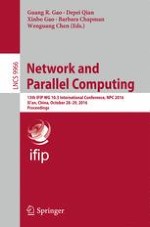2016 | Buch
Network and Parallel Computing
13th IFIP WG 10.3 International Conference, NPC 2016, Xi'an, China, October 28-29, 2016, Proceedings
herausgegeben von: Guang R. Gao, Depei Qian, Xinbo Gao, Barbara Chapman, Wenguang Chen
Verlag: Springer International Publishing
Buchreihe : Lecture Notes in Computer Science
